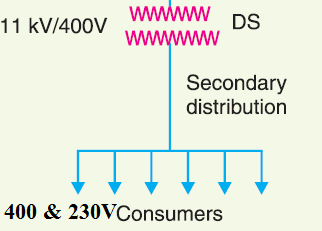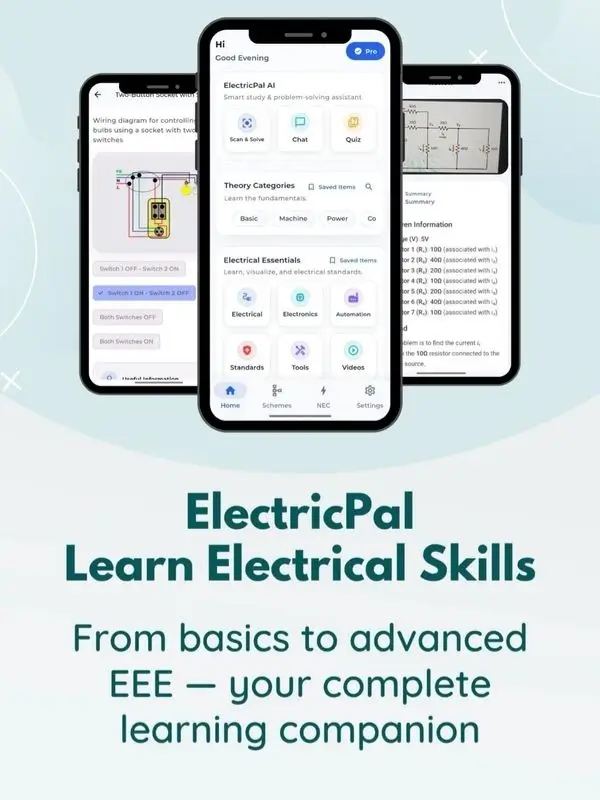The electric power transmission and distribution system is essential for delivering electricity from power stations to consumers. This complex network ensures that power generated at distant power plants reaches homes, businesses, and industries. Comprising power stations, transmission lines, and distribution lines, this system plays a crucial role in maintaining a reliable electricity supply across vast areas. In this article, we will explore the primary components of the electric power supply system, including how power is generated, transmitted, and distributed.
Electric Power Transmission and Distribution System – The method of transmitting power from the power station to the consumer for the sale of electric power (consumer-level transmission) is called the electric supply system.
Electric Power Transmission and Distribution System
The Electric Power supply system is composed of three main components:
- Power Station
- Transmission Line
- Distribution Line
Electric power is generated at the power station or power plant. The consumer is located far from the power station.
This power is transmitted to distant locations via conductor wires, known as transmission lines.
Finally, the power is transmitted to consumers via the distribution line. We will learn more about this below.
Transmission lines can be divided into two types:
- Primary Transmission Line
- Secondary Transmission Line
Distribution lines can also be divided into two types:
- Primary Transmission Line
- Secondary Distribution Line
The electric power system design is shown below:
The design of the power supply system shown here may not match every type of design, and some supply systems may not have all the components shown in the above diagram.
Generating Station:
In the diagram below, GS stands for Generating Station.

The generated voltage at this station is 11 kV. Sometimes the generated power is 6.6 or 3.3 kV.
This 11 kV voltage is stepped up to 132 kV using a step-up transformer because there are many advantages to transmitting electric power over long distances at high voltage.
Primary Transmission:
The 11 kV voltage from the generating station is transformed to 132 kV using a step-up transformer.

This high voltage is transmitted over long distances via a three-wire overhead system. This 132 kV transmission voltage is stepped down to 33 kV using a step-down transformer and transmitted to the receiving station. This is essentially the function of primary transmission.
Secondary Transmission:
In the primary transmission system, the 132 kV transmission line ends at the receiving station via a step-down transformer. This station is similar to the generating station, but instead of a generator, there is a step-up transformer.

This transformer typically converts 33 kV voltage to 11 kV voltage. It is then transmitted again via a three-phase three-wire overhead system. It ends at the substations in various cities. This is essentially the function of secondary transmission.
Primary Distribution:
The secondary transmission line with 33 kV voltage ends at the substation, where there is a step-down transformer.

This step-down transformer converts the 33 kV voltage to 11 kV. Sometimes this 11 kV voltage is sent to big consumers (industries, factories, mills) directly from the primary distribution because their demand exceeds 50 kW.
Secondary Distribution:
The primary distribution line of 11 kV voltage goes to the distribution substation (DS), which is located near the consumers or residential areas.

The distribution substation contains a step-down transformer that converts the 11 kV voltage to 400 volts. Finally, this 400 volts is supplied to houses through a three-phase four-wire system.
In this case, the voltage difference between two phases is 400 volts, and the voltage difference between any one phase and neutral is 230 volts.
The electric power transmission and distribution system is a vital infrastructure that ensures electricity reaches consumers efficiently and safely. From generating stations to transmission and distribution lines, each component plays a specific role in ensuring the stable flow of electricity. Understanding this system provides insight into the complex process of power delivery, highlighting the importance of each stage in maintaining a consistent energy supply to homes, businesses, and industries across the world.
What are the 3 types of transmission lines?
The three main types of transmission lines are overhead transmission lines, underground transmission lines, and submarine transmission lines. Overhead lines are the most common, supported by towers or poles, while underground and submarine lines are used in areas where overhead lines are impractical or need to be hidden for aesthetic or environmental reasons.
What is the difference between transmission and distribution of electricity?
Transmission of electricity refers to the high-voltage transfer of electric power from power plants to substations over long distances. Distribution involves stepping down the voltage and delivering electricity from substations to consumers, such as homes and businesses, over shorter distances.
What is electric power distribution?
Electric power distribution is the process of delivering electricity from the substations to end consumers, including homes, businesses, and industries. It involves lower voltage networks and typically uses a combination of overhead and underground lines to supply electricity to different areas.
What is electric power transmission?
Electric power transmission refers to the high-voltage transfer of electricity from power plants to substations over long distances. This system is designed to minimize energy losses and efficiently transport power across vast regions to the points where it will be distributed to consumers.
What is power system operation and control?
Power system operation and control refers to the management of electrical power generation, transmission, and distribution to ensure a stable, reliable, and efficient electricity supply. It involves balancing demand and supply, managing voltage levels, and preventing system faults or failures.
What is the electrical power transmission and distribution system?
The electrical power transmission and distribution system is the network that carries electricity from generation facilities to consumers. Transmission involves moving electricity over long distances at high voltages, while distribution delivers lower-voltage electricity to homes and businesses for everyday use.
What is electricity generation, transmission, and distribution?
Electricity generation involves producing electrical power at power plants using resources like coal, natural gas, solar, or wind. Transmission moves this electricity over long distances at high voltages to substations. Distribution lowers the voltage and delivers the electricity to consumers for practical use.
What are the three types of electric power distribution?
The three types of electric power distribution systems are radial systems, ring main systems, and interconnected systems. Radial systems are simple and low-cost but less reliable, while ring and interconnected systems offer greater reliability and fault tolerance.
What is generation and utilization of electrical energy?
The generation of electrical energy refers to the process of producing electricity at power plants, while the utilization of electrical energy involves its practical use by consumers for activities such as lighting, heating, and operating appliances or industrial equipment.




